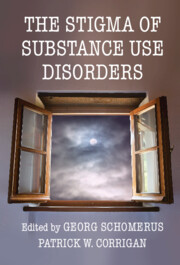Book contents
- The Stigma of Substance Use Disorders
- The Stigma of Substance Use Disorders
- Copyright page
- Contents
- Figures
- Tables
- Contributors
- Chapter 1 Understanding the Stigma of Substance Use Disorders
- Chapter 2 My Experience with the Stigma of Substance Use
- Chapter 3 Substance Use Stigma and Policy
- Chapter 4 Experiences of Stigma and Criminal In/Justice among People Who Use Substances
- Chapter 5 Substance Use Disorders, Stigma, and Ethics
- Chapter 6 Intersectional Stigma in Substance Use Disorders
- Chapter 7 International Perspectives on Stigma toward People with Substance Use Disorders
- Chapter 8 Using Community-Based Participatory Research to Address the Stigma of Substance Use Disorder
- Chapter 9 Three Competing Agendas of Addressing Stigma of Substance Use Disorder
- Chapter 10 The Benefits of Disclosure
- Chapter 11 The Role of Peers in SUD Stigma Change
- Chapter 12 The Role of Media Reporting for Substance Use Stigma
- Chapter 13 Reducing Substance Use Stigma in Health Care
- Chapter 14 Final Considerations and Future Directions for Erasing the Stigma of Substance Use Disorders
- Index
- References
Chapter 12 - The Role of Media Reporting for Substance Use Stigma
Published online by Cambridge University Press: 23 June 2022
- The Stigma of Substance Use Disorders
- The Stigma of Substance Use Disorders
- Copyright page
- Contents
- Figures
- Tables
- Contributors
- Chapter 1 Understanding the Stigma of Substance Use Disorders
- Chapter 2 My Experience with the Stigma of Substance Use
- Chapter 3 Substance Use Stigma and Policy
- Chapter 4 Experiences of Stigma and Criminal In/Justice among People Who Use Substances
- Chapter 5 Substance Use Disorders, Stigma, and Ethics
- Chapter 6 Intersectional Stigma in Substance Use Disorders
- Chapter 7 International Perspectives on Stigma toward People with Substance Use Disorders
- Chapter 8 Using Community-Based Participatory Research to Address the Stigma of Substance Use Disorder
- Chapter 9 Three Competing Agendas of Addressing Stigma of Substance Use Disorder
- Chapter 10 The Benefits of Disclosure
- Chapter 11 The Role of Peers in SUD Stigma Change
- Chapter 12 The Role of Media Reporting for Substance Use Stigma
- Chapter 13 Reducing Substance Use Stigma in Health Care
- Chapter 14 Final Considerations and Future Directions for Erasing the Stigma of Substance Use Disorders
- Index
- References
Summary
What people know and how they think about drug use, consumption practices, and addiction is considerably influenced by the way the topic is talked about and framed in the media. Problems associated with the stigma of substance use disorders (SUDs) point to the need to identify factors that contribute to stigmatization and the urgency to outline courses of action to combat the stigma of addiction and other SUDs. The chapter first lays out the role the media take regarding the stigmatization of people with SUDs and refers to theoretical approaches in communication science. Findings on the coverage of people with SUDs in the media and mechanisms that lead to stigmatizing portrayals are delineated. In a second step, media guidelines as a possible means to strengthen the destigmatizing role of the media are described and discussed. Against this background, the media’s role in reporting for substance use stigma is discussed.
- Type
- Chapter
- Information
- The Stigma of Substance Use Disorders , pp. 213 - 231Publisher: Cambridge University PressPrint publication year: 2022
References
- 1
- Cited by



